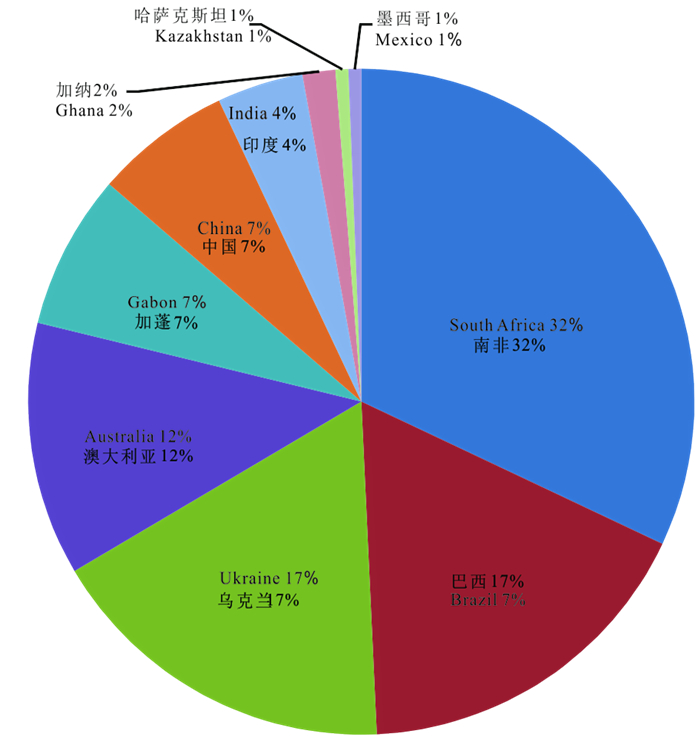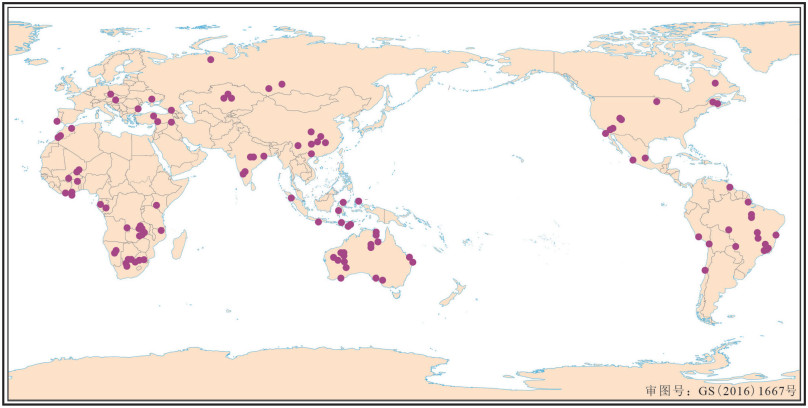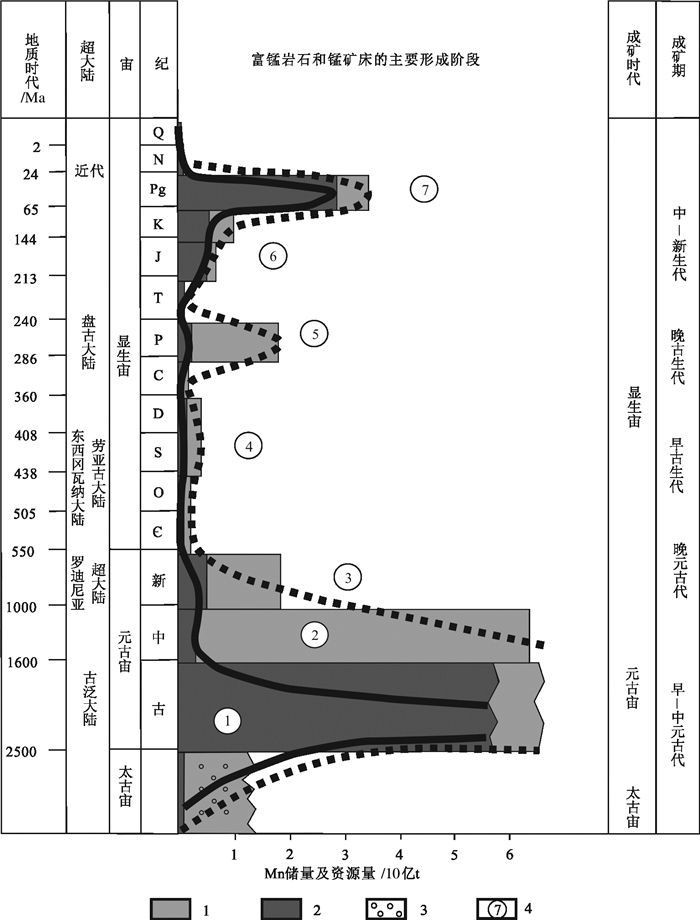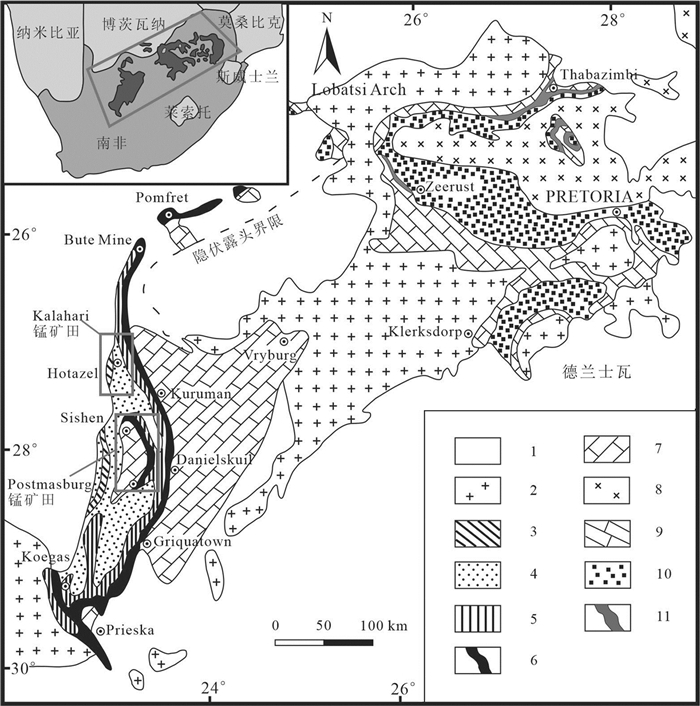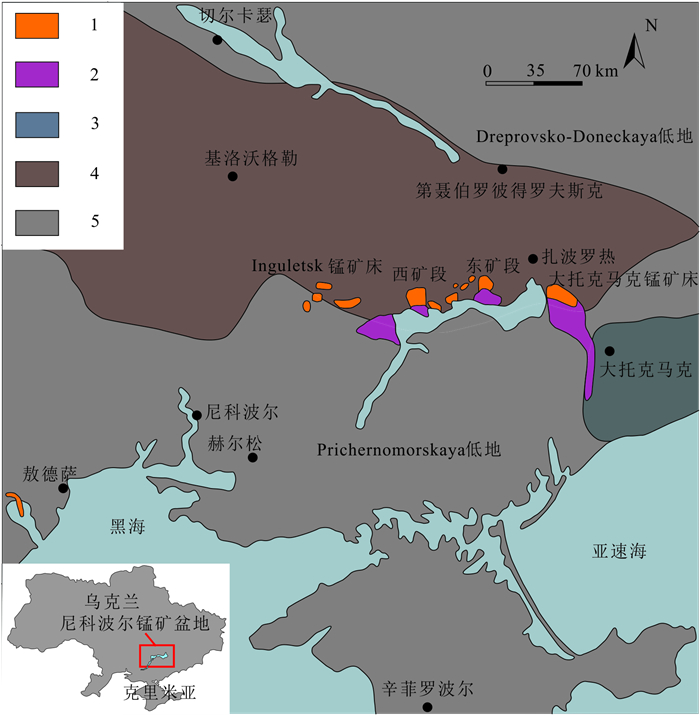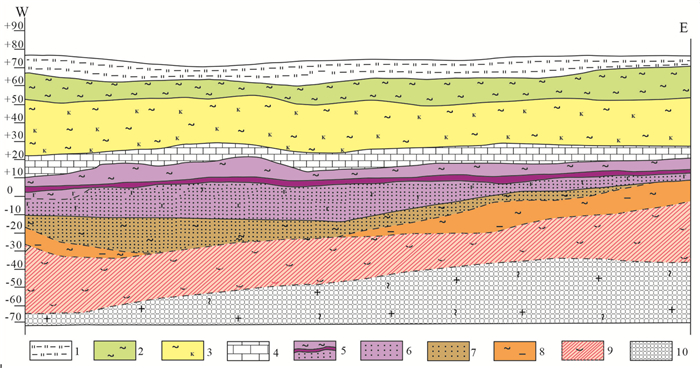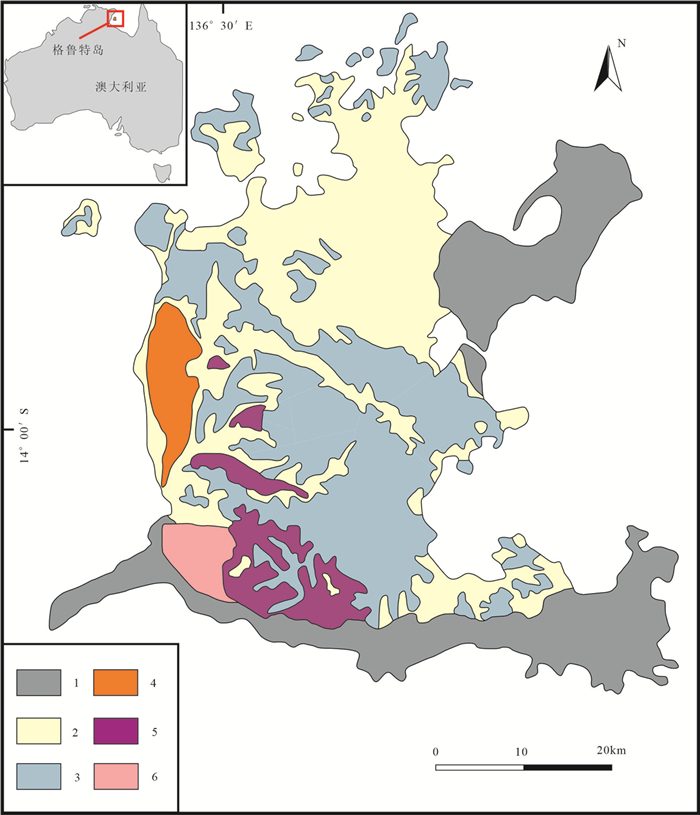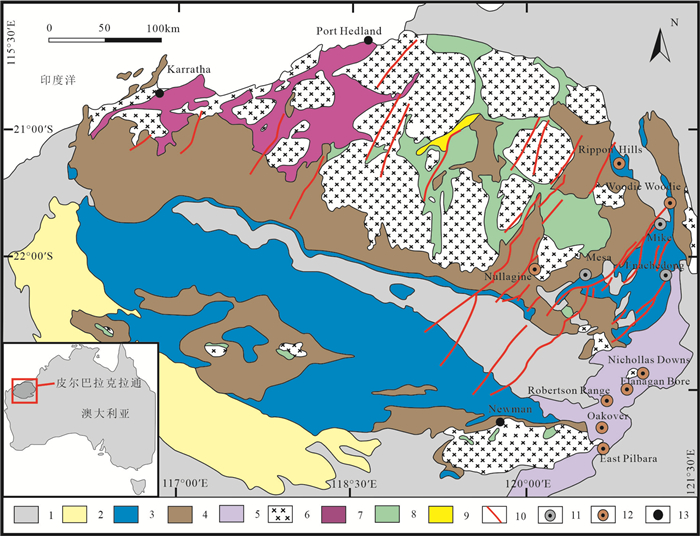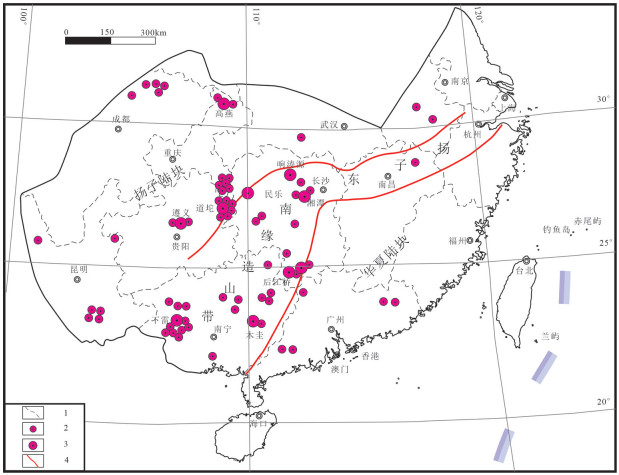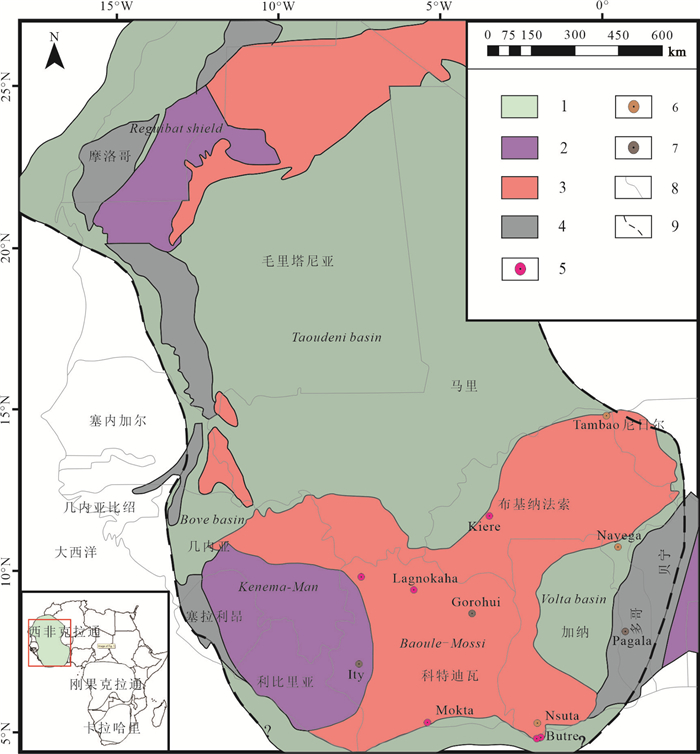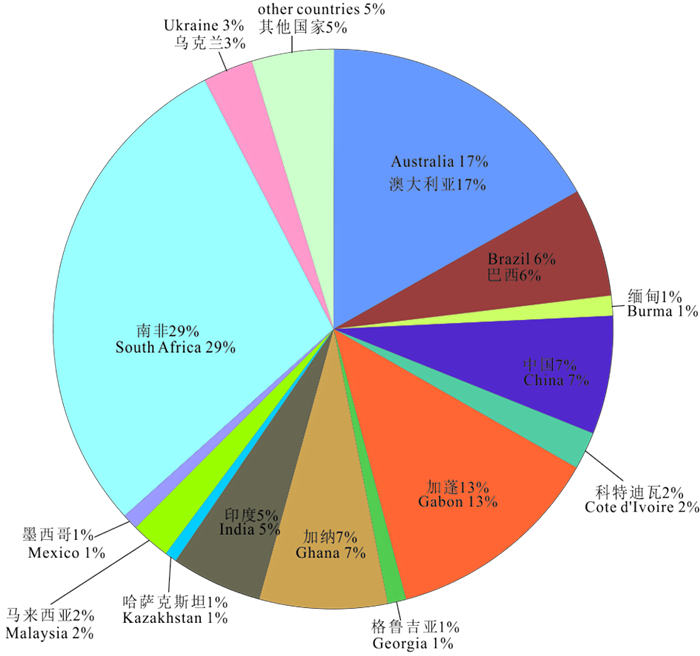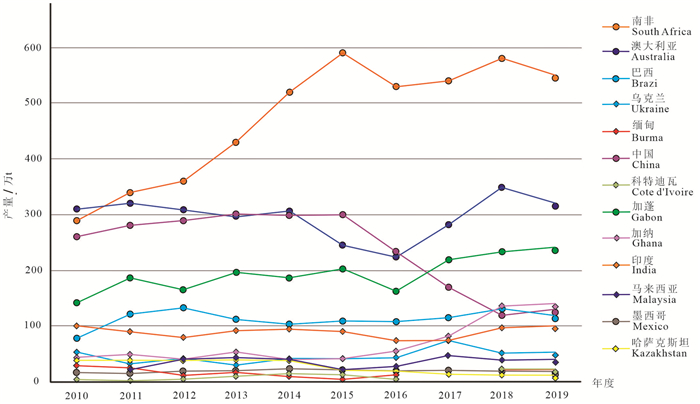-
摘要:
锰的用途非常广泛,世界上90%~95%的锰应用于冶金工业,其余应用于电池工业、陶瓷工业、化学工业等。根据成矿作用过程中的含矿岩系特征,将世界锰矿划分为海相沉积型、火山(热液)-沉积型、变质型、热液型和表生型5类,以海相沉积型、变质型和表生型为主。截至2019年,世界锰的储量达8.12亿t,但分布极不均匀,主要集中在南非、巴西、乌克兰、澳大利亚、加蓬、中国、印度、加纳等国,而优质锰矿石主要分布在南非、澳大利亚、加蓬、加纳。时间上,将锰的成矿作用分为7期,其中元古宙和新生代是主要的成矿期。空间上,锰矿床主要分布在南非德兰士瓦群、乌克兰尼科波尔盆地、澳大利亚格鲁特岛和皮尔巴拉克拉通、中国泛扬子区、西非克拉通等。目前,锰的生产主要集中在南非的卡拉哈里和波斯特马斯堡锰矿田、澳大利亚的格鲁特岛、加蓬的莫安达锰矿、加纳的恩苏塔锰矿等地。
Abstract:Manganese is widely used, 90%~95% of the world's manganese is used in the metallurgical industry, the rest in the battery industry, ceramic industry, chemical industry and so on. According to the characteristics of ore-bearing rocks in the process of mineralization, the world manganese deposits are divided into five types, including marine sedimentary type, volcanic (hydrothermal)-sedimentary type, metamorphic type, hydrothermal type and supergene type, with marine sedimentary type, metamorphic type and supergene type as the main ones. By the end of 2019, the worldwide manganese reserves had reached up to 812 million tons, but their distribution is extremely uneven, mainly concentrated in South Africa, Brazil, Ukraine, Australia, Gabon, China, India, Ghana and so on, while the high quality manganese ores are mainly distributed in South Africa, Australia, Gabon and Ghana. The mineralization epoch of manganese can be divided into 7 periods, of which Proterozoic and Cenozoic are of great importance. Manganese deposits are spatially concentrated in the Transvaal Supergroup of South Africa, the Nikopol ore Basin in Ukraine, the Groote Eylandt and Pilbara Craton of Australia, the Pan-Yangtze area of China, the West African Craton. At present, manganese ore production is mainly concentrated in Kalahari and Postmasburg ore fields in South Africa, Groote Island in Australia, Moanda mine in Gabon and Nsuta mine in Ghana.
-
Keywords:
- manganese /
- type /
- distribution /
- development
-
1. 引言
造山型金矿床作为重要的金矿床类型,其占世界黄金资源的30%以上(Groves et al., 1988)。造山带中形成的造山型金矿床主要位于由挤压或走滑变形中应力相对低的区域,如次级断裂构造中(McCuaig et al., 1988)。大多数造山型金矿床是在绿片岩相变质条件下形成的(Goldfarb et al., 2001, 2015; Deng and Wang, 2016)。造山型金矿的成矿流体和金的来源是至今尚未解决的问题(卢焕章等, 2018)。一般认为成矿流体中的Au(HS)2-络合物是金元素运输及富集的载体(McCuaig et al., 1988)。金成矿流体来源多样,包括:(1)岩石变质作用(Groves et al., 2003); (2)含碳沉积物(Large et al., 2011); (3)岩浆热液(Tomkins et al., 2013); (4)海水(Chang et al., 2008); (5)变质脱水(Phillips and Powell, 2009, 2010)。事实上各个时代的大多数造山型金矿床的成矿流体具有盐度低(≤10%NaCleqv),高碳(CO2 + CH4含量为5%~30%),低Cl和高S含量等特征(卢焕章等, 2018)。而造山型金矿床成矿流体的一致性,说明它们可能来自相同或者是多阶段形成的热液流体(卢焕章, 1991;卢焕章和池国祥, 1995)。此外,造山型金矿的成矿时代也是其研究的热点,争论的焦点主要在于是形成于变质峰期前(Phillips and Powell, 2009, 2010;Tomkins, 2010)还是变质峰期与峰期后(Groves et al., 1998;Goldfarb et al., 2005)。前者主要认为造山带在抬升剥蚀过程中,变质峰期与地壳的深度有关,即越深则达到峰期的时间越晚,且也可能受到之后变质作用的叠加,从而表现出成矿时代比围岩变质时期晚(Phillips and Powell, 2010)。后者则基于造山型金矿的成矿时代统计(Knight et al., 1993, 2000;Dziggel et al., 2010;Kolb et al., 2015),并结合变质时代、蚀变特征、穿切关系等。同时,前人研究发现这些造山型金矿的成矿峰期与陆壳增生速率的峰期和超大陆拼合峰期吻合较好(Goldfarb et al., 2001)。
造山型金矿床也是中国重要的黄金来源,广泛分布于天山造山带(Chen et al., 2012),哀牢山构造带(Zhang et al., 2018),华北克拉通北缘(Hart et al., 2002)和中国西北的造山带(Mao et al., 2000; Zhang et al., 2009;李猛等,2020)。柴达木盆地北缘(简称柴北缘)造山带是中国西北部的重要的造山带之一,含有一系列Au、Cu、Pb和Zn矿床(Zhang et al., 2009)。本区是中国重要的金成矿带,目前发现9个金矿床,金矿化点十余处,远景资源量在300 t以上。前人研究认为这些金矿与造山作用密切相关,但缺乏系统性总结,从而限制了我们对柴北缘造山型金矿的理解。本文在前人研究和最新地质资料的基础上,对柴北缘造山型金矿进行初步探讨,希望能够对柴北缘造山型金矿的找矿工作有所启迪。
2. 地质背景
柴北缘造山带整体走向为西北-东南,长约900 km,宽25~160 km(图 1)。北邻祁连造山带,南接柴达木地块(柴达木盆地)(Song et al., 2014; 蔡鹏捷等,2019)。欧龙布鲁克—牦牛山断裂将柴北缘从欧龙布鲁克地块向北分离(Chen et al., 2009)。在其西北端,造山带被阿尔金断裂切割(Wittlinger et al., 1998)。前人研究表明,柴达木盆地北部在早奥陶世发生俯冲,与祁连地块的碰撞发生在晚奥陶世到中泥盆世(Yang, 2002; 蔡鹏捷等, 2018)。
![]() 1—胜利沟金矿;2—野骆驼泉金矿;3—千枚岭金矿;4—红柳沟金矿;5—青龙沟金矿;6—滩间山金矿;7—鱼卡金矿;8—双口山金矿;9—赛坝沟金矿Figure 1. Schematic map showing the major tectonic units in northwest China (a, modified from Song et al., 2013) and simplified map showing the tectonic framework of the northern Qaidam(b, modified from Zhang et al., 2009)1-Shengligou gold deposit; 2-Yeluotuoquan gold deposit; 3-Qianmeiling gold deposit; 4-Hongliugou gold deposit; 5-Qinglonggou gold deposit; 6-Tanjianshan gold deposit; 7-Yuka gold deposit; 8-Shuangkoushan gold deposit; 9-Saibagou gold deposit
1—胜利沟金矿;2—野骆驼泉金矿;3—千枚岭金矿;4—红柳沟金矿;5—青龙沟金矿;6—滩间山金矿;7—鱼卡金矿;8—双口山金矿;9—赛坝沟金矿Figure 1. Schematic map showing the major tectonic units in northwest China (a, modified from Song et al., 2013) and simplified map showing the tectonic framework of the northern Qaidam(b, modified from Zhang et al., 2009)1-Shengligou gold deposit; 2-Yeluotuoquan gold deposit; 3-Qianmeiling gold deposit; 4-Hongliugou gold deposit; 5-Qinglonggou gold deposit; 6-Tanjianshan gold deposit; 7-Yuka gold deposit; 8-Shuangkoushan gold deposit; 9-Saibagou gold deposit柴北缘的主要岩石地层单位包括古元古界达肯大板岩群、中—新元古界鱼卡河岩群、滩间山岩群和下古生界弧相关的火山和沉积岩(Zhang et al., 2017a, b)。柴北缘作为著名的超高压变质带,前人通过对高压/超高压变质岩(榴辉岩和片麻岩)和花岗岩的地质年代学和地球化学研究,建立了一个大陆碰撞造山带从早期海底俯冲(>440 Ma)、大陆俯冲和碰撞(440~ 420 Ma)、俯冲板块的剥露(420~390 Ma)和最终造山带崩塌(390~360 Ma)的演化模型(Song et al., 2014;张建新等, 2015;Zhang et al., 2017a, b)。
3. 柴北缘造山型金矿床地质概况
俯冲相关增生造山作用的成矿模型预测,柴北缘有利于造山型成矿(Goldfarb et al., 2001, 2015; Deng and Wang, 2016)。柴北缘造山带已发现大量的造山型金矿床,包括胜利沟、野骆驼泉、千枚岭、红柳沟、青龙沟、滩间山、赛坝沟、鱼卡和双口山,以蚀变岩型和石英脉型为主(国家辉, 1998;张德军, 2001, 2005, 2007a, 2007b;Zhang et al., 2009;范贤斌, 2017;孟和, 2017;蔡鹏捷等, 2018)。
柴北缘造山型金矿的地质特征见表 1。总体上,柴北缘的造山带金矿体主要赋存于中元古界、寒武系和奥陶系低品位变质岩发育的剪切带中(Deng and Wang, 2016)。其中胜利沟、野骆驼泉、千枚岭、红柳沟、鱼卡和双口山金矿主要产于寒武—奥陶系滩间山群,青龙沟和滩间山金矿产于中元古界万洞沟群,赛坝沟金矿的赋矿围岩为中粗粒花岗闪长岩-英云闪长岩。基本上所有金矿的围岩蚀变包括硅化、绿泥石化、绢云母化,部分还有碳酸盐化(千枚岭、红柳沟、滩间山、鱼卡、双口山),黄铁绢英岩化(赛坝沟金矿)。多数金矿体的展布与NW向的韧性剪切或断层破碎带相关,少数还与次级构造有关(野骆驼泉、千枚岭、青龙沟、滩间山、双口山)。矿石构造大部分为浸染状、细脉浸染状,部分可见团块状矿石(滩间山和鱼卡)。这些金矿的元素组合均表现为Au-As。
Table 1. Geological characteristics of the orogenic gold deposits in Northern Qaidam
4. 金矿成矿温度特征
对柴北缘造山型金矿与成矿相关的流体包裹体均一温度、冰点、盐度等进行统计(表 2,图 2):野骆驼泉(CO2-H2O型:峰值177~261℃和270~341℃,盐度为1.6%~8.9%;H2O-NaCl型:119~437℃,冰点为-7.8~-0.9℃,盐度为1.6%~11.4%)(张德全等, 2001)、滩间山(CO2-H2O型:峰值在186~250℃和280~296℃,盐度为1.4%~7.9%;H2O-NaCl型:121~ 449℃,冰点为-7.0~-0.9℃,盐度为1.6%~10.5%) (张德全等, 2001)、千枚岭(CO2-H2O型:峰值191~ 243℃,299℃,盐度为2.4%~7.3%;H2O-NaCl型:124~358℃,冰点-6.9~-1.5℃,盐度为2.6%~10.3%) (张德全等, 2001)、青龙沟(CO2- H2O型:200~ 245℃,293~299℃,盐度为1.8%~8.3%;H2O-NaCl型:129~418℃,冰点为-6.0~-0.7℃,盐度为1.2%~ 9.2%)(张德全等, 2001)、红柳沟(CO2-H2O型:213~ 245℃,295℃,盐度为2.4%~8.1%;H2O-NaCl型:129~420℃,冰点为- 5.9~- 1.2℃,盐度为2.1% ~ 9.1%)(张德全等, 2001)、鱼卡(CO2-H2O型:193~ 249℃;H2O- NaCl型:188~285℃,冰点为- 7.5~-0.7℃,盐度为1.22%~11.10%)(范贤斌, 2017;蔡鹏捷, 2018)、双口山(CO2-H2O型:252~290℃,320~ 358℃;H2O-NaCl型:161~365.6℃,冰点为-5.6~ -3.0℃,盐度为1.91%~14.25%)(孟和, 2017)、胜利沟(H2O- NaCl型:120~209℃,206~385℃,冰点为-9.7~-1.8℃,盐度为3.06%~13.62%)(黄亚, 2013)。
Table 2. Temperature measurement data of fluid inclusions of orogenic gold deposits in the northern Qaidam (datas from Zhang et al., 2001; Huang, 2013; Fan, 2017; Meng, 2017; Cai et al., 2018)
![]() Figure 2. Histogram showing homogenization temperature of fluid inclusions of the orogenic gold deposits in the northern Qaidam (after Zhang et al., 2001; Huang, 2013; Fan, 2017; Meng, 2017; Cai et al., 2018c)
Figure 2. Histogram showing homogenization temperature of fluid inclusions of the orogenic gold deposits in the northern Qaidam (after Zhang et al., 2001; Huang, 2013; Fan, 2017; Meng, 2017; Cai et al., 2018c)不难看出,成矿流体的均一在各个矿床之间存在一定的差异。这种差异应该是与成矿作用时的压力-温度不同有关,也与围岩的组成有关。但这些矿床的成矿温度还是在200~400℃,仅有几十度的差别,均在造山型金矿的成矿温度(卢焕章等, 2018)。大部分矿床(点) 中呈双峰态分布, 只有少部分矿床(点)中呈单峰态分布。张德全(2007)对柴北缘—东昆仑金矿流体包裹体研究认为,这可能与不同造山时期的成矿作用有关,且对应了低盐度的H2O-CO2-NaCl-CH4(晚加里东碰撞造山期)和H2O-CO2-NaCl±CH4(晚华力西—印支碰撞造山期)两种不同的成矿流体。
一般认为金成矿具有多个成矿阶段, 从早期的高温阶段到后期的低温阶段(卢焕章等, 2018)。金矿化主要包含了4个阶段:①乳白色石英黄铁矿阶段;②含金石英黄铁矿阶段;③含金多金属硫化物石英阶段;④碳酸盐阶段(卢焕章等, 2018)。前人对柴北缘造山型金矿流体包裹体的研究主要针对与金矿的成矿流体相关第二和第三阶段。对柴北缘造山型金矿的流体包裹体显微观察,均发现有富CO2型、含CO2水溶液型(CO2-H2O型)和水溶液型(H2O-NaCl型) 三类,这与典型的造山型金矿中流体包裹体类型是一致的(Groves et al., 1998; Kerrich et al., 2000; Hagemann and Cassidy, 2000; 陈衍景等, 2007)。
5. 金成矿流体与物质来源
5.1 氢、氧同位素特征
利用与成矿相关的氢、氧同位素,能够有效地揭示成矿流体的来源,区分其来源岩浆水、变质水或大气降水,从而有助于判别流体的演化轨迹和矿床成因(杨利亚等, 2013)。造山型金矿的成矿流体往往经历了长距离迁移,其氢、氧同位素组成除了反映源区性质之外,可能表征沿着流体通道的水/岩反应、源区和围岩或后期流体的混合特征(Ridley and Diamond, 2000; Beaudoin and Pitre, 2005; 蔡鹏捷, 2019)。
柴北缘造山型金矿成矿流体中δ18OH2O-SNOW = -1.7‰ ~ 10.31‰和δDV- SMOW = -113.8 ‰~ -41.6 ‰ (表 3,图 3),其中滩间山金矿δ18OH2O-SNOW = 9.15‰ ~ 10.31‰,δDV-SMOW=-69.9‰ ~ -50‰;青龙沟金矿δ18OH2O - SNOW =- 1.7‰ ~ 5.5‰,δDV- SMOW=- 95.1‰ ~ -71.4‰;鱼卡金矿δ18OH2O-SNOW =5.2‰ ~ 6.01‰,δDV-SMOW=-58.5‰ ~-41.6‰;双口山金矿δ18OH2O-SNOW = 5.75‰ ~ 6.45‰,δDV-SMOW=-113.8‰ ~ -99.8‰。柴北缘这些金矿的H-O同位素特征,是无法用单一大气水或原生岩浆水的参与解释,只有是在复杂的造山过程中变质流体受到岩浆水及大气水等共同作用所导致。从图 3也可见,整个柴北缘金矿的H-O同位素基本上也与华北克拉通北缘、小秦岭、西秦岭、东昆仑等造山带中的造山型金矿范围重叠。
表 3 柴北缘造山型金矿H-O同位素Table 3. δ18O and δD values of the orogenic gold deposits in the northern Qaidam
![]() 图 3 柴北缘造山型金矿δD与δ18Owater比值图(底图据Deng and Wang, 2016)1—双口山金矿;2—滩间山金矿;3—青龙沟金矿;4—鱼卡金矿Figure 3. δD (‰) vs. δ18Owater (‰) diagram of the orogenic gold deposits in the northern Qaidam (modified from Deng and Wang, 2016)1-Shuangkoushan gold deposit; 2-Tanjianshan gold deposit; 3- Qinglonggou gold deposit; 4-Yuka gold deposit
图 3 柴北缘造山型金矿δD与δ18Owater比值图(底图据Deng and Wang, 2016)1—双口山金矿;2—滩间山金矿;3—青龙沟金矿;4—鱼卡金矿Figure 3. δD (‰) vs. δ18Owater (‰) diagram of the orogenic gold deposits in the northern Qaidam (modified from Deng and Wang, 2016)1-Shuangkoushan gold deposit; 2-Tanjianshan gold deposit; 3- Qinglonggou gold deposit; 4-Yuka gold deposit5.2 硫、铅同位素特征
硫化物的硫同位素组成对于追踪成矿物质来源和约束成矿过程是非常有效的(Hodkiewicz et al., 2009)。柴北缘金矿中含金黄铁矿的δ34S在0.5‰~ 11‰,主要集中在5‰~9‰(表 4,图 4),其中滩间山金矿δ34S为5.31‰~8.54‰;青龙沟金矿δ34S为5.0‰ ~11.0‰;鱼卡金矿δ34S为0.5‰~7.4‰;双口山金矿δ34S为6.0‰ ~10.0‰;红柳沟金矿δ34S为3.9‰ ~4.4‰。总体柴北缘金矿黄铁矿的δ34S与金矿类型进行对比,主要落在造山型金矿和卡林型金矿范围内,源区特征主要落在变质岩类型的范围内(图 4),推测成矿流体在上升过程中与通道围岩发生水-岩作用而产生的混合硫,总体上指示了带内的金矿应属于造山型金矿。
表 4 柴北缘造山型金矿S同位素特征Table 4. Analytical results of S isotope of the orogenic gold deposits in Northern Qaidam
![]() 图 4 柴北缘造山型金矿与其他类型S同位素对比(据Deng and Wang, 2016修改)Figure 4. Comparison of S isotopes between orogenic gold deposits in the northern margin of Qaidam and other types of gold deposits
图 4 柴北缘造山型金矿与其他类型S同位素对比(据Deng and Wang, 2016修改)Figure 4. Comparison of S isotopes between orogenic gold deposits in the northern margin of Qaidam and other types of gold deposits矿石的铅同位素同样是一类对成矿来源的有效示踪工具(Doe and Stacey, 1974; Zartman and Doe, 1981)。柴北缘金矿中黄铁矿或共生方铅矿的206Pb/204Pb为18.238~19.296,207Pb/204Pb为15.547~ 15.773,208Pb/204Pb为37.918~38.978,∆β为14.15~ 29.79,∆γ为11.95~51.92(表 5)。其中胜利沟金矿中方铅矿的206Pb/204Pb为18.300~18.374,207Pb/204Pb为15.602~15.688,208Pb/204Pb为38.054~38.346,∆β为14.15~20.28,∆γ为11.95~18.38(表 5);滩间山金矿中黄铁矿的206Pb/204Pb为18.476~19.296,207Pb/204Pb为15.547~15.641,208Pb/204Pb为37.918~38.211,∆β为18.55~24.41,∆γ为28.66~36.42(表 5);鱼卡金矿中黄铁矿的206Pb/204Pb为18.238~18.62,207Pb/204Pb为15.59~ 15.618,208Pb/204Pb为38.039~38.775,∆β为16.96~ 18.78,∆γ为15.29~34.82(表 5);双口山金矿中方铅矿的206Pb/204Pb为18.437~18.567,207Pb/204Pb为15.617~ 15.773,208Pb/204Pb为38.466~38.978,∆β为15.33~ 29.79,∆γ为32.26~51.92,黄铁矿的206Pb/204Pb为18.435~18.460,207Pb/204Pb为15.604~15.634,208Pb/204Pb为38.431~38.531,∆β为18.24~20.91,∆γ为26.03~ 30.10(表 5)。柴北缘金矿含金矿物的Pb同位素投点可见主要落在了上地壳和造山带演化线之间(图 5),这些Pb同位素特征说明柴北缘金矿的成矿物质大多来源于地幔—上地壳的混合作用(图 6),且一定程度上受到了岩浆作用的影响,也指示了其应该与造山作用相关。
表 5 柴北缘造山型金矿Pb同位素特征Table 5. Pb-isotpic compositions and characteristic parameters of orgen gold deposits in the northern Qaidam
![]() 图 5 柴北缘造山型金矿Pb同位素构造图解(底图据Zartman and Doe, 1981)1—双口山金矿;2—滩间山金矿;3—胜利沟金矿;4—鱼卡金矿Figure 5. Pb isotope diagrams of the orogenic gold deposits in the northern Qaidam (basic diagram modified from Zartman and Doe, 1981)Pb isotope diagrams of the orogenic gold deposits in the northern Qaidam (basic diagram modified from Zartman and Doe, 1981)
图 5 柴北缘造山型金矿Pb同位素构造图解(底图据Zartman and Doe, 1981)1—双口山金矿;2—滩间山金矿;3—胜利沟金矿;4—鱼卡金矿Figure 5. Pb isotope diagrams of the orogenic gold deposits in the northern Qaidam (basic diagram modified from Zartman and Doe, 1981)Pb isotope diagrams of the orogenic gold deposits in the northern Qaidam (basic diagram modified from Zartman and Doe, 1981)![]() 图 6 柴北缘造山型金矿Pb同位素Δβ-Δγ图解(底图据朱炳泉等, 1998)1—地幔源Pb; 2—上地壳源Pb; 3—上地壳与地幔混合的俯冲带Pb (3a—岩浆作用; 3b—沉积作用); 4—化学沉积型Pb; 5—海底热水作用Pb; 6—中深变质作用Pb; 7—深变质下地壳Pb; 8—造山带Pb; 9—古老页岩上地壳Pb; 10—退变质作用Pb;11—双口山金矿;12—滩间山金矿;13—胜利沟金矿;14—鱼卡金矿Figure 6. Pb isotope Δβ-Δγ diagram of the orogenic gold deposits in the northern Qaidam (basic diagram modified from Zhu et al., 1998)1- mantle lead; 2-upper crust lead; 3- subduction zone lead mixed with upper crust and mantle(3a -magmatism; 3b- deposition); 4- chemical deposition lead; 5- submarine hot water lead; 6-mesometamorphism lead; 7- katametamorphism lower crust lead; 8-orogenic belt lead; 9- ancient shale upper crust lead; 10- retrograde metamorphism lead; 11-Shuangkoushan gold deposit; 12-Tanjianshan gold deposit; 13-Shengligou gold deposit; 14-Yuka gold deposit
图 6 柴北缘造山型金矿Pb同位素Δβ-Δγ图解(底图据朱炳泉等, 1998)1—地幔源Pb; 2—上地壳源Pb; 3—上地壳与地幔混合的俯冲带Pb (3a—岩浆作用; 3b—沉积作用); 4—化学沉积型Pb; 5—海底热水作用Pb; 6—中深变质作用Pb; 7—深变质下地壳Pb; 8—造山带Pb; 9—古老页岩上地壳Pb; 10—退变质作用Pb;11—双口山金矿;12—滩间山金矿;13—胜利沟金矿;14—鱼卡金矿Figure 6. Pb isotope Δβ-Δγ diagram of the orogenic gold deposits in the northern Qaidam (basic diagram modified from Zhu et al., 1998)1- mantle lead; 2-upper crust lead; 3- subduction zone lead mixed with upper crust and mantle(3a -magmatism; 3b- deposition); 4- chemical deposition lead; 5- submarine hot water lead; 6-mesometamorphism lead; 7- katametamorphism lower crust lead; 8-orogenic belt lead; 9- ancient shale upper crust lead; 10- retrograde metamorphism lead; 11-Shuangkoushan gold deposit; 12-Tanjianshan gold deposit; 13-Shengligou gold deposit; 14-Yuka gold deposit6. 柴北缘造山型金成矿时代
前人对柴北缘构造带中的金矿相关的成岩成矿时代进行了厘定(表 6):野骆驼泉金矿成矿时代为(246.0±3.0)Ma(张德全等, 2005);青龙沟金矿成矿时代为(409.4±2.3)Ma(张德全等, 2005)、(410.3± 5.8)Ma(张德全等, 2005)、274.6 Ma(林文山等, 2006);滩间山金矿成矿时代为409.4 Ma(张德全等., 2001)、401 Ma(张德全等, 2001)、(394±6)Ma (Li, 2011)、385.8 Ma(崔艳合等, 2000)、(356±2.8) Ma(贾群子等, 2013)、(350.4 ± 3.2)Ma(张博文, 2010)、(344.7±2)Ma(李世金, 2011)、(344±2.2)Ma(张博文, 2010)、(330±24.3)Ma(张德全等, 2001)、(288.9±7.3)Ma(崔艳合等, 2000)、(289.6±6)Ma(崔艳合等, 2000)、288 Ma(Zhang et al., 2009)、(284.04±2.95)Ma(张德全等, 2005)、284 Ma(张德全等, 2005)、(275.9 ± 7.2)Ma(崔艳合等, 2000)、(268.94 ± 4.31)Ma(崔艳合等, 2000)、268.9 Ma (Zhang et al., 2009)、209 Ma(国家辉, 1998);鱼卡金矿成矿时代为(376.9±4.0)Ma、(387.5±7.2)Ma(范贤斌, 2017);双口山金矿成矿时代为(357.7±5.28)Ma (孟和, 2017);赛坝沟金矿成矿时代为(425.5±2.1) Ma(丰成友等, 2002)、(426±2)Ma(张德全等, 2005)、(210±3)Ma(丰成友等, 2002)。上述成矿时代指示了柴北缘造带中的金矿大多与复合造山过程有关。
表 6 柴北缘造山型金矿相关成岩与成矿时间Table 6. Diagenetic and metallogenic ages of orogenic gold deposits in the northern Qaidam
将柴北缘金矿成矿时期与岩浆活动和构造运动分期进行对比(图 7),综合前人研究,可见寒武—奥陶纪时期,柴北缘的洋盆逐渐关闭,洋壳俯冲导致岛弧火山岩(滩间山岩群)的形成,洋壳俯冲结束后,柴达木地块与欧龙布鲁克微陆块开始碰撞,形成了加里东期的柴北缘碰撞造山带(赵志新,2018),造山期后的一系列岩浆活动奠定了柴北缘造山型金矿形成的基础(张德全等, 2001, 2005;Zhang et al., 2009)。整个柴北缘造山型金矿的成矿期主要集中在426~376 Ma、357~330 Ma和288~246 Ma三个时期。第一个成矿期与区域的加里东期碰撞造山过程相关,第二成矿期与陆内裂解的岩浆活动有关,第三成矿期则与晚华力西—印支期造山过程有关。其中加里东晚期,柴达木陆块向祁连陆块的俯冲由正向俯冲变成斜向俯冲,导致区域上形成了一条右行剪切走滑构造带,同时柴北缘这种应力的转变也进一步促进了岩浆活动的加剧及地层的褶皱变形,从而导致成矿热液流体沿原有构造体系发生叠加富集(丰成友等, 2002; 张德全等, 2005)。从时间上,不难看出,第一时期是属于柴北缘超高压变质峰期之后,该期矿床成矿时代的差异应该是所处不同位置及成矿深度导致。第二成矿期属于柴北缘碰撞造山后地壳增厚后减薄时期,岩浆活动对金矿的进一步富化。第三成矿期则是古特提斯洋的开合导致该区新的造山活动,热液与岩浆新的叠加作用。事实上,一般认为挤压或者从伸展到挤压的转换阶段,才是造山型金矿最有利的形成时期(王庆飞等,2019)。柴北缘大部分的造山型金矿都属于一次造山作用的产物,而带内滩间山、青龙沟、塞巴沟等经历了两期以上,其中滩间山金矿的三期复合成矿作用可能是导致其成为柴北缘最大金矿的原因。
![]() 图 7 柴北缘构造事件、岩浆活动与金矿成矿时代耦合图(据赵志新,2018修改)1—青龙沟金矿;2—滩间山金矿;3—鱼卡金矿;4—双口山金矿;5—赛坝沟金矿;6—野骆驼泉金矿;7—镁质钙性-钙碱性花岗岩;8—钙碱性花岗岩;9—钙碱-碱钙性花岗岩;10—钙碱花岗岩、拉斑质基性岩;11—碱性花岗岩Figure 7. Coupling diagram showing tectonic event, magmatic activity and metallogenic age of gold deposits in the northern Qaidam (modified from Zhao Zhixin, 2018)1-Qinglonggou gold deposit; 2-Tanjianshan gold deposit; 3-Yuka gold deposit; 4-Shuangkoushan gold deposit; 5-Saibagou gold deposit; 6- Yeluotuoquan gold deposit; 7-Magnesian calc alkaline granite; 8-Calc alkaline granite; 9-Calc alkaline- alkali calcium granite; 10-Calc alkaline granite, tholeiitic basic rock; 11-Alkaline granite
图 7 柴北缘构造事件、岩浆活动与金矿成矿时代耦合图(据赵志新,2018修改)1—青龙沟金矿;2—滩间山金矿;3—鱼卡金矿;4—双口山金矿;5—赛坝沟金矿;6—野骆驼泉金矿;7—镁质钙性-钙碱性花岗岩;8—钙碱性花岗岩;9—钙碱-碱钙性花岗岩;10—钙碱花岗岩、拉斑质基性岩;11—碱性花岗岩Figure 7. Coupling diagram showing tectonic event, magmatic activity and metallogenic age of gold deposits in the northern Qaidam (modified from Zhao Zhixin, 2018)1-Qinglonggou gold deposit; 2-Tanjianshan gold deposit; 3-Yuka gold deposit; 4-Shuangkoushan gold deposit; 5-Saibagou gold deposit; 6- Yeluotuoquan gold deposit; 7-Magnesian calc alkaline granite; 8-Calc alkaline granite; 9-Calc alkaline- alkali calcium granite; 10-Calc alkaline granite, tholeiitic basic rock; 11-Alkaline granite7. 结论
(1) 柴北缘造山型金矿主要赋存在中元古代、寒武系和奥陶系低品位变质岩发育的剪切带中,且多数矿体的展布与NW向的构造相关。
(2) 柴北缘造山型金矿大部分矿床(点) 成矿温度呈双峰态分布, 只有少部分矿床(点)中呈单峰态分布,指示了受到多期流体作用。
(3) 柴北缘造山型金矿的成矿流体中δ18OH2O-SMOW=-1.7‰ ~ 10.31‰和δDV-SMOW = -113.8 ‰ ~ -41.6 ‰,指示其变质流体受到岩浆水及大气水等共同作用。含金硫化物(黄铁和方铅矿)的δ34S在0.5‰ ~11‰,主要集中在5‰ ~9‰,206Pb/204Pb为18.238~19.296,207Pb/204Pb为15.547~15.773,208Pb/204Pb为37.918~38.978,指示了成矿物质来源于地幔-上地壳,且一定程度上都受到了岩浆作用的影响。
(4)柴北缘的复合造山运动导致造山型金矿存在(426~376)Ma、(357~330)Ma和(288~246)Ma三个成矿期。
致谢: 审稿专家和编辑老师对论文提出了宝贵的意见和建议,在此表示衷心的感谢! -
图 3 地球不同历史时期锰的储量和资源量分布情况(据Kuleshov, 2011修改)
1—储量;2—资源量;3—太古宙含锰岩石;4—主要成矿阶段
Figure 3. Distribution of manganese reserves and resources in different historical periods of the earth (modified from Kuleshov, 2011)
1-Reserves; 2-Resources; 3-Archen manganiferous rocks; 4-Major Mn metallogenic phases
图 4 南非德兰士瓦群地质简图及主要锰矿床(据Pickard, 2003和Moore et al., 2012修改)
1—盖层;2—基底;3—Griqualand BIF带;4—Griqualand群;5—Griquatown碧玉岩组;6—Kuruman BIF带;7—Campbellrand白云岩;8—Bushveld杂岩体;9—Malmani白云岩;10—Pretoria群;11—Penge BIF带
Figure 4. Simplified geological map of the Transvaal supergroup showing distribution of manganese deposits (modified from Pickard, 2003 and Moore et al., 2012)
1-Cover rocks; 2-Basement rocks; 3-Griqualand BIF; 4-Griqualand Group; 5-Griquatown jasper; 6-Kuruman BIF; 7-Campbellrand dolomite; 8-Bushveld complex; 9-Malmani dolomite; 10-Pretoria Group; 11-Penge BIF
图 5 尼科波尔锰矿盆地地质简图及主要锰矿床(据Kuleshov, 2003修改)
1—氧化锰矿石;2—碳酸锰矿石;3—亚速断块;4—乌克兰地盾;5—黑海沿岸低地
Figure 5. Simplified geological map of the Nikopol ore Basin showing distribution of manganese deposits (modified from Kuleshov, 2003)
1-Oxide ores; 2-Carbonate ores; 3-Azov massif; 4-Ukrainian shield; 5-Prichernomorskaya nizm
图 6 尼科波尔锰矿横截面图(据Ahmet et al., 2020修改)
1—土壤;2—红棕色黏土;3—灰黑色黏土;4—灰岩;5—钙质黏土、石英砂、锰矿;6—石英—海绿石砂;7—黏土;8—炭质黏土和砂;9—风化壳;10—混合岩、斜长花岗岩
Figure 6. Geological cross section of the Nikopol manganese deposit (modified from Ahmet et al., 2020)
1-Loam; 2-Red-brown clay; 3-Dark-gray clay; 4-limestone; 5-Alcareous clay, quartz sand and Mn ores; 6-Quartz-glauconite sand; 7-Clay; 8- Carbonaceous clay and sand; 9-Weathering crust; 10-Migmatite and plagiogranite
图 7 澳大利亚格鲁特岛地质简图(据Pracejus et al., 1988修改)
1—沙丘;2—砂、黏土;3—砂岩;4—豆状MnO2;5—浸染状MnO2;6—含锰钙质粉砂岩
Figure 7. Simplified geological map of the Groote Eylandt (modified from Pracejus et al., 1988)
1-Sand dunes; 2-Sand, clays; 3-Sandstone; 4-Podifrom MnO2;5-Disseminated MnO2;6-Manganiferous calcareous siltstone
图 8 皮尔巴拉克拉通地质简图及主要锰矿床分布(据Blake et al., 2011和Sheppard et al., 2017修改)
1—新生代盖层;2—Ashburton组;3—Hamersley群;4—Fortescue群;5—Maganese群;6—花岗岩;7—西皮尔巴拉地体;8—东皮尔巴拉地体;9—Lalla Rookh盆地;10—断裂;11—BIF型锰矿床;12—表生型锰矿床;13—城市
Figure 8. Simplified geological map of Pilbara Craton showing distribution of manganese deposits (modified from Blake et al., 2011 and Sheppard et al., 2017)
1-Cenozoic sedimentary covers; 2-Ashburton Formation; 3-Hamersley Group; 4-Fortescue Group; 5-Maganese Group; 6-Granite; 7-West Pilbara terrane; 8-East Pilbara terrane; 9-Lalla Rookh basin; 10-Fault; 11-BIF Mn deposit; 12-Supergene Mn deposit; 13-Town
图 9 中国华南地区大中型锰矿分布图(据Xiang et al., 2020和王剑等,2012修改)
1—省界;2—中型锰矿;3—大型锰矿;4—构造边界
Figure 9. Distribution map of large to mid-sized manganese deposits in southern China (modified from Xiang et al., 2020 and Wang et al., 2012)
1-Province boundary; 2-Moderate-size Mn ores; 3-Large Mn ores; 4-Tectonic boundary
图 10 西非克拉通地质简图及锰矿(据Markwitz et al., 2016修改)
1—西非克拉通;2—太古宙;3—古元古代;4—泛非活动带;5—沉积型锰矿;6—沉积型、表生型锰矿;7—BIF型锰矿;8—国界;9—西非克拉通边界
Figure 10. The simplified geological map of the West African Craton showing distribution of manganese deposits (modified from Markwitz et al., 2016)
1-West African Craton; 2-Archean; 3-Paleoproterozoic; 4-Pan-African belts; 5-Sedimentary Mn deposit; 6- Sedimentary and supergene Mn deposit; 7- BIF Mn deposit; 8-National boundary; 9-Boundary of West African Craton
表 1 世界锰矿床成因分类(据谢进,2017修改)
Table 1 The genetic types of manganese deposits in the world (modified from Xie Jin, 2017)

表 2 2019年世界主要锰矿国锰矿储量
Table 2 The world's major manganese ore reserves in 2019

表 3 世界大型锰矿床分布情况
Table 3 The distribution of large-sized manganese deposits in the world

表 4 近10年世界主要锰矿生产国的锰产量(万t)
Table 4 Manganese production of the major countries rich in manganese in the last ten years (ten thousand ton)

表 5 中国2014—2018年度进口的锰资源量(万t)
Table 5 Imported manganese resources of China from 2014 to 2018(ten thousand tons)

-
Ahmet S, Vasyl M Z, Bigle S. 2020. Major, trace and rare earth element (REE) geochemistry of the Oligocene stratiform manganese oxide-hydroxide deposits in the Nikopol, Ukraine[J]. Ore Geology Reviews, 126:1-15 http://www.sciencedirect.com/science/article/pii/S0169136820306284
Beauvais A, Ruffet G, Hénocque O, Colin F. 2008. Chemical and physical erosion rhythms of the West African Cenozoic morphogenesis:The 39Ar-40Ar dating of supergene K-Mn oxides[J]. Journal of Geophysical Research, 113:1-15. doi: 10.1029/2008jf000996
Beukes N J, Burger A M, Gutzmer J. 1995. Fault controlled hydrothermal alteration of Paleoproterozoic manganese ore in Wessels mine, Kalahari manganese field[J]. South Africa Journal Geology, 98(4):430-451. http://sajg.geoscienceworld.org/content/98/4/430
Biondi J C, Lopez M. 2017. Urucum Neoproterozoic-Cambrian manganese deposits (MS, Brazil):Biogenic participation in the ore genesis, geology, geochemistry, and depositional environment[J]. Ore Geology Reviews, 91:335-386. doi: 10.1016/j.oregeorev.2017.09.018
Blake T S, Rothery E, Muhling J R, Drake-Brockman J A P, Sprigg L C, Ho S E, Rasmussen B, Fletcher I R. 2011. Two episodes of regional-scale Precambrian hydrothermal alteration in the eastern Pilbara, western Australia[J]. Precambrian Research, 188(1/4):73-103. http://www.sciencedirect.com/science/article/pii/S0301926811000738
Brusnitsyn A I, Zhukov I G. 2012. Manganese deposits of the Devonian magnitogorsk paleovolcanic belt (southern Urals, Russia)[J]. Ore Geology Reviews, 47:42-58. doi: 10.1016/j.oregeorev.2012.01.003
Chang Honglun, Kong Fanhui, Song Xiaodong, Zhao Jin, Li Jianfeng, Du Jun, Wang Congyin. 2014. Dolostone controls in Postmasburg manganese field of South Africa[J]. Acta Sedimentologica Sinica, 32(5):832-839(in Chinese with English abstract). http://en.cnki.com.cn/Article_en/CJFDTOTAL-DZLP201403011.htm
Chen Yuchuan, Wang Denghong, Xu Zhigang. 2015. Important Mineral and Regional Metallogenic Regularity in China[M]. Beijing:Geological Publishing House(in Chinese).
Chetty D, Gutzmer J. 2012. REE redistribution during hydrothermal alteration of ores of the Kalahari manganese deposit[J]. Ore Geology Reviews, 47:126-135. doi: 10.1016/j.oregeorev.2011.06.001
Cong Yuan, Dong Qingjie, Xiao Keyan, Chen Jianping, Gao Yongbao, Yin Jiangning. 2018. Characteristics and predicted potential of Mn resources in China[J]. Earth Science Frontiers, 25(3):118-137(in Chinese with English abstract). http://www.researchgate.net/publication/327766360_Characteristics_and_predicted_potential_of_Mn_resources_in_China
De Putter T, Liégeois J, Dewaele S, Cailteux J, Boyce A, Mees F. 2018. Paleoproterozoic manganese and base metals deposits at Kisenge-Kamata (Katanga D R. Congo)[J]. Ore Geology Reviews, 96:181-200. doi: 10.1016/j.oregeorev.2018.04.015
Deng Wenbing, Zhang Yanwen, Kong Linghu, Shang Lei. 2019. Current status of manganese ore resources in China and selecting for national physical geological data of manganese ore deposits[J]. China Mining Magazine, 28(9):175-182(in Chinese with English abstract).
Du Q, Yi H, Hui B, Li S, Xia G, Yang W, Wu X. 2013. Recognition, genesis and evolution of manganese ore deposits in southeastern China[J]. Ore Geology Reviews, 55:99-109. doi: 10.1016/j.oregeorev.2013.05.001
Dzigbodi-Adjimah K. 2004. The mineralogy and petrography of the ferruginous manganese rocks at Mankwadzi, Ghana[J]. Journal of African Earth Sciences, 38(3):293-315. doi: 10.1016/j.jafrearsci.2003.08.001
Fairey B J, Timmerman M J, Sudo M, Tsikos H. 2019. The role of hydrothermal activity in the formation of karst-hosted manganese deposits of the Postmasburg mn field, Northern Cape Province, South Africa[J]. Minerals, 9(7):408-436. doi: 10.3390/min9070408
Fu Yong, Xu Zhigang, Pei Haoxiang, Jiang Ran. 2004. Study on metallogenic regularity of manganese ore deposits in China[J]. Acta Geologica Sinica, 88(12):2192-2207(in Chinese with English abstract). http://en.cnki.com.cn/Article_en/CJFDTOTAL-DZXE201412004.htm
Ghosh R, Chakraborty D, Halder M, Baidya T K. 2015. Manganese mineralization in Archean greenstone belt, Joda-Noamundi sector, Noamundi basin, east Indian shield[J]. Ore Geology Reviews, 70:96-109. doi: 10.1016/j.oregeorev.2015.04.007
Gunn A G, Dorbor J K, Mankelow J M, Lusty P A J, Deady E A, Shaw R A, Goodenough K M. 2018. A review of the mineral potential of Liberia[J]. Ore Geology Reviews, 101:413-431. doi: 10.1016/j.oregeorev.2018.07.021
Gutzmer J, Beukes N.J.1995. Fault controlled metasomatic alteration of early Proterozoic sedimentary manganese ores in the Kalahari manganese field, South Africa[J]. Economic Geology, 90:823-844. doi: 10.2113/gsecongeo.90.4.823
Gutzmer J, Du Plooy A P, Beukes N J. 2012. Timing of supergene enrichment of low-grade sedimentary manganese ores in the Kalahari manganese field, South Africa[J]. Ore Geology Reviews, 47:136-153. doi: 10.1016/j.oregeorev.2012.04.003
He Hui. 2017. A present situation of Mn-ore resources and its investigation[J]. China's Manganese Industry, 35(1):23-24(in Chinese with English abstract). http://en.cnki.com.cn/Article_en/CJFDTotal-ZGMM201701007.htm
Hein K A A, Tshibubudze A. 2016. Manganese deposits of the Oudalan province in the northeast of Burkina Faso, and Ansongo Inlier in eastern Mali[J]. Ore Geology Reviews, 78:645-651. doi: 10.1016/j.oregeorev.2015.11.008
Hong Shikun. 2011. Status of China Mn-ore in resources exploitation and the sustainable development[J]. China's Manganese Industry, 29(3):13-16(in Chinese with English abstract). http://search.cnki.net/down/default.aspx?filename=ZGMM201103007&dbcode=CJFD&year=2011&dflag=pdfdown
Hu Dewen, Feng Dandan. 2011. An analysis of the constraints on Chinese manganese industry[J]. China Mining Magazine, 20(6):1-8(in Chinese with English abstract). http://en.cnki.com.cn/Article_en/CJFDTOTAL-ZGKA201106002.htm
Klein C, Ladeira E.A. 2004. Geochemistry and mineralogy of Neoproterozoic Banded Iron Formations and some selected, siliceous manganese formations from the Urucum district, Mato Grosso do Sul, Brazil[J]. Economic Geology, 99(6):1233-1244. doi: 10.2113/gsecongeo.99.6.1233
Kuleshov V N. 2003. Isotopic composition (δ13C, δ18O) and origin of manganese carbonate ores from the early Oligocene deposits, the eastern paratethys[J]. Geochemistry, 63(4):329-363. doi: 10.1078/0009-2819-00029
Kuleshov V N. 2011. Manganese deposits:communication 2. Major epochs and phases of manganese accumulation in the Earth's history[J]. Lithology and Mineral Resources, 46:546-565. doi: 10.1134/S0024490211060095
Laznika P.1992. Manganese deposits in the global lithogenetic system:Quantitative approach[J]. Ore Geology Reviews, 7(4):279-356. doi: 10.1016/0169-1368(92)90013-B
Li Guiliang. 2018. Status quo of manganese ore in China[J]. China's Manganese Industry, 36(3):5-7(in Chinese with English abstract). http://en.cnki.com.cn/Article_en/CJFDTotal-ZGMM201803003.htm
Luo Huabao. 2002. The direction of prospecting for high quality manganese ore resources in China[J]. Geology and Exploration, 38(4):8-11(in Chinese with English abstract).
Maghfouri S, Rastad E, Mousivand F, Choulet F, Ye L. 2017. Geological and geochemical constraints on the Cheshmeh-Frezi volcanogenic stratiform manganese deposit, southwest Sabzevar basin, Iran[J]. Ore Geology Reviews, 89:96-113. doi: 10.1016/j.oregeorev.2017.06.015
Markwitz V, Hein K A A, Jessell M W, Miller J. 2016. Metallogenic portfolio of the West Africa craton[J]. Ore Geology Reviews, 78:558-563. doi: 10.1016/j.oregeorev.2015.10.024
Markwitz V, Hein K A A, Miller J. 2016. Compilation of West African mineral deposits:Spatial distribution and mineral endowment[J]. Precambrian Research, 274:61-81. doi: 10.1016/j.precamres.2015.05.028
Moore J M, Polteau S, Armstrong R A, Corfu F, Tsikos H. 2012. The age and correlation of the Postmasburg Group, southern Africa:Constraints from detrital zircon grains[J]. Journal of African Earth Sciences, 64:9-19. doi: 10.1016/j.jafrearsci.2011.11.001
Nayak B, Das S K, Bhattacharyya K K. 2011. Detrital and authigenic(?) baddeleyite (ZrO2) in ferromanganese nodules of central Indian ocean basin[J]. Geoscience Frontiers, 2:571-576. doi: 10.1016/j.gsf.2011.08.001
Ostwald J. 1988. Mineralogy of the Groote Eylandt manganese oxides:A review[J]. Ore Geology Reviews, 4(1):3-45. http://www.sciencedirect.com/science/article/pii/0169136888900030
Pickard A. 2003. SHRIMP U-Pb zircon ages for the Paleoproterozoic Kuruman Iron Formation, Northern Cape Province, South Africa:Evidence for simultaneous BIF deposition on Kaapvaal and Pilbara Cratons[J]. Precambrian Research, 125(3/4):275-315. http://www.sciencedirect.com/science/article/pii/S030192680300113X
Pracejus B, Bolton B R, Frakes L A. 1988. Nature and development of supergene manganese deposits, Groote Eylandt, northern Territory, Australia[J]. Ore Geology Reviews, 4(1):71-98. http://www.sciencedirect.com/science/article/pii/0169136888900054
Roy S. 2006. Sedimentary manganese metallogenesis in response to the evolution of the earth system[J]. Earth Science Reviews, 77:273-305. doi: 10.1016/j.earscirev.2006.03.004
Salama W, Aref M E, Gaupp R. 2012. Mineralogical and geochemical investigations of the middle Eocene ironstones, El Bahariya Depression, western Desert, Egypt[J]. Gondwana Research, 22:717-736. doi: 10.1016/j.gr.2011.11.011
Sethumadhav M S, Gunnell Y, Ahmed M M, Chinnaiah. 2010. Late Archean manganese mineralization and younger supergene maganese ores in the Anmod-Bisgod region, western Dharwar Craton, southern India:Geological characterization, palaeoenvironmental history, and geomorphological setting[J]. Ore Geology Reviews, 38:70-89. doi: 10.1016/j.oregeorev.2010.06.001
Sharkov A A. 2000. Manganese raw mineral base of russia and problem of its utilization[J]. Razved Okhr Nedr, 11:15-19.
Sheppard S, Krapez B, Zi J W, Rasmussen B, Fletcher I R. 2017. Young ores in old rocks:Proterozoic iron mineralisation in Mesoarchean Banded Iron Formation, northern Pilbara Craton, Australia[J]. Ore Geology Reviews, 89:40-69. doi: 10.1016/j.oregeorev.2017.06.003
U.S.Geological Survey. 2011. Mineral Commodity Summaries[R].
U.S.Geological Survey. 2012. Mineral Commodity Summaries[R].
U.S.Geological Survey. 2013. Mineral Commodity Summaries[R].
U.S.Geological Survey. 2014. Mineral Commodity Summaries[R].
U.S.Geological Survey. 2015. Mineral Commodity Summaries[R].
U.S.Geological Survey. 2016. Mineral Commodity Summaries[R].
U.S.Geological Survey. 2017. Mineral Commodity Summaries[R].
U.S.Geological Survey. 2018. Mineral Commodity Summaries[R].
U.S.Geological Survey. 2019. Mineral Commodity Summaries[R].
U.S.Geological Survey. 2020. Mineral Commodity Summaries[R].
Vafeas N A, Blignaut L C, Viljoen K S. 2019. Arsenic-bearing manganese ore of the Mukulu enrichment in the Kalahari manganese Field, South Africa:A new discrimination scheme for Kalahari manganese ore[J]. Ore Geology Reviews, 115:103146. doi: 10.1016/j.oregeorev.2019.103146
Wang Jian, Duan Taizhong, Xie Yuan, Wang Zhengjiang, Hao Ming, Liu Wei. 2012. The tectonic evolution and its oil and gas prospect of southeast margin of Yangtze Block[J]. Geological Bulletin of China, 31(11):1739-1749(in Chinese with English abstract). http://en.cnki.com.cn/Article_en/CJFDTOTAL-ZQYD201211002.htm
Xiang J, Chen J, Bagas L, Li S, Wei H, Chen B. 2020. Southern China's manganese resource assessment:An overview of resource status, mineral system, and prediction model[J]. Ore Geology Reviews, 116:103261. doi: 10.1016/j.oregeorev.2019.103261
Xie Jin. 2017. Analysis on Investment Prospect of One Belt And One Road Manganese Ore Resources[D]. Beijing: China University of Geosciences (Beijing) (in Chinese).
Xu Shiqi, Xue Chunji, Feng Jing, Feng Changrong. 2019. Study on metallogenic regularity of manganese deposits of Xinjiang[J]. Xiangjiang Geology, 37(2):201-206(in Chinese with English abstract). http://en.cnki.com.cn/Article_en/CJFDTotal-XJDI201902012.htm
Yan Wangsheng, Gao Hailiang. 2009. The resource of Mn ore and its development of Mn-Mining[J]. China's Manganese Industry, 27(3):6-11(in Chinese with English abstract). http://en.cnki.com.cn/Article_en/CJFDTOTAL-ZGMM200903002.htm
Yin Jiangning, Xiao Keyan. 2014. Resources potential analysis and metallogenic prospect of Mn resources in China[J]. Geology in China, 41(5):1424-1436(in Chinese with English abstract). http://www.researchgate.net/publication/288973332_Resources_potential_analysis_and_metallogenic_prospect_of_Mn_resources_in_China
Zang Zhongjiang, Sui Yanhui. 2019. An analysis of the present situation and utilization of manganese ore resources in Russian Federation[J]. China's Manganese Industry, 37(4):1-7(in Chinese with English abstract). http://en.cnki.com.cn/Article_en/CJFDTotal-ZGMM201904001.htm
Zhang Jingsheng, Zhou Guanghua. 2006. A review of manganese ore resources in China and its processing technology progress[J]. China's Manganese Industry, 24(1):1-5(in Chinese with English abstract). http://en.cnki.com.cn/Article_en/CJFDTOTAL-ZGMM200601000.htm
Zhang Jiuling. 1982. Geological characteristics and prospecting direction for domestic and foreign manganese mine[J]. Geology and Prospecting, 18(2):26-40(in Chinese).
Zhou Liuxia. 2000. Mining conditions and problems about China's Mn mines and some proposals[J]. China Mining Magazine, 9(49):51-54(in Chinese with English abstract). http://www.cnki.com.cn/Article/CJFDTotal-ZGMM200001002.htm
常洪伦, 孔繁辉, 宋晓东, 赵晋, 李建锋, 杜俊, 王聪颖. 2014.南非Postmasburg锰矿田白云岩的控矿作用[J].沉积学报, 32(5):832-839. https://www.cnki.com.cn/Article/CJFDTOTAL-CJXB201405005.htm 陈毓川, 王登红, 徐志刚. 2015.中国重要矿产和区域成矿规律[M].北京:地质出版社. 丛源, 董庆吉, 肖克炎, 陈建平, 高永宝, 阴江宁.2018.中国锰矿资源特征及潜力预测[J].地学前缘, 25(3):118-137. https://www.cnki.com.cn/Article/CJFDTOTAL-DXQY201803013.htm 邓文兵, 张彦文, 孔令湖, 尚磊. 2019.中国锰矿资源现状与国家级锰矿床实物地质资料筛选[J].中国矿业, 28(9):175-182. https://www.cnki.com.cn/Article/CJFDTOTAL-ZGKA201909032.htm 付勇, 徐志刚, 裴浩翔, 姜冉. 2014.中国锰矿成矿规律初探[J].地质学报, 88(12):2192-2207. https://www.cnki.com.cn/Article/CJFDTOTAL-DZXE201412004.htm 何辉. 2017.锰矿资源现状与锰矿勘查研究[J].中国锰业, 35(1):23-24. https://www.cnki.com.cn/Article/CJFDTOTAL-ZGMM200402001.htm 洪世琨.2011.我国锰矿资源开采现状与可持续发展的研究[J].中国锰业, 29(3):13-16. doi: 10.3969/j.issn.1002-4336.2011.03.004 胡德文, 冯丹丹. 2011.我国锰矿产业问题分析[J].中国矿业, 20(6):1-8. doi: 10.3969/j.issn.1004-4051.2011.06.001 黎贵亮. 2018.中国锰矿山现状[J].中国锰业, 36(3):5-7. https://www.cnki.com.cn/Article/CJFDTOTAL-ZGMM201803003.htm 骆华宝. 2002.我国优质锰矿的勘查方向[J].地质与勘探, 38(4):8-11. doi: 10.3969/j.issn.0495-5331.2002.04.002 王剑, 段太忠, 谢渊, 汪正江, 郝明, 刘伟. 2012.扬子地块东南缘大地构造演化及其油气地质意义[J].地质通报, 31(11):1739-1749. doi: 10.3969/j.issn.1671-2552.2012.11.001 谢进. 2017.一带一路锰矿资源投资前景分析[D].北京: 中国地质大学(北京). 徐仕琪, 薛春纪, 冯京, 冯昌荣. 2019.新疆锰矿成矿规律研究[J].新疆地质, 37(2):201-206. doi: 10.3969/j.issn.1000-8845.2019.02.010 严旺生, 高海亮.2009.世界锰矿资源及锰矿业发展[J].中国锰业, 27(3):6-11. doi: 10.3969/j.issn.1002-4336.2009.03.002 阴江宁, 肖克炎. 2014.中国锰矿资源潜力分析及成矿预测[J].中国地质, 41(5):1424-1436. doi: 10.3969/j.issn.1000-3657.2014.05.002 臧忠江, 隋延辉. 2019.俄罗斯锰矿资源现状与利用情况[J].中国锰业, 37(4):1-7. https://www.cnki.com.cn/Article/CJFDTOTAL-ZGMM201904001.htm 张泾生, 周光华. 2006.我国锰矿资源及选矿进展评述[J].中国锰业, 24(1):1-5. doi: 10.3969/j.issn.1002-4336.2006.01.001 张九龄. 1982.国内外锰矿主要类型地质特征及找矿方向[J].地质与勘探, 18(2):26-40. https://www.cnki.com.cn/Article/CJFDTOTAL-DZKT198202004.htm 周柳霞. 2000.我国锰矿山的开采现状问题与建议[J].中国矿业, 9(49):51-54. https://www.cnki.com.cn/Article/CJFDTOTAL-ZGKA2000S1009.htm -
期刊类型引用(9)
1. 俞军真,郑有业,王永才,王建国,马波,贾翠霞,张琳琳. 柴北缘青龙沟金矿床闪长玢岩锆石年代学、黄铁矿原位硫同位素和微量元素特征及找矿启示. 黄金. 2024(11): 9-17+136 .  百度学术
百度学术
2. 甄世民,查钟健,王大钊,刘家军,庞振山,程志中,薛建玲,王江,白海军,李阳,陈超. 河北张宣地区中山沟金矿成矿流体特征及其对侵入岩型碲金矿床的限定. 中国地质. 2023(02): 605-621 .  本站查看
本站查看
3. 赵呈祥,薛春纪,赵晓波,李鹏,刘洋涛,李君阳,赵伟策,李健. 柴北缘造山带滩间山金矿田多期侵入岩年代学及其地质意义. 地质与勘探. 2023(03): 591-607 .  百度学术
百度学术
4. 张灵桧. 柴达木盆地西北缘交通社金矿地质特征及找矿前景. 中国锰业. 2023(04): 83-88 .  百度学术
百度学术
5. 王进寿,潘彤,薛万文,李鹏,安永尉,田永革,雷晓清,余福承. 青海省柴北缘成矿带区域成矿规律综述. 矿床地质. 2022(05): 917-938 .  百度学术
百度学术
6. 徐永利,郑有业,许荣科,严康,左恒斌. 基于成矿元素复杂度的地球化学数据处理方法在找矿实践中的应用——以柴北缘造山带绿梁山地区为例. 黄金. 2022(11): 25-30 .  百度学术
百度学术
7. 唐名鹰,何宗围,朱德全,张宇,高振华,董振昆,李小东. 柴北缘赛坝沟金矿床硫、铅同位素组成:对成矿物质来源的指示. 矿床地质. 2021(01): 117-127 .  百度学术
百度学术
8. 童海奎,龙灵利,马永胜,仓索南尖措,吴鸿梅. 青海大柴旦镇尕日力根砾岩型金矿成矿特征研究. 矿产勘查. 2021(03): 534-541 .  百度学术
百度学术
9. 李顺庭,龙灵利,王宁. 韧性剪切带型金矿研究进展. 矿产勘查. 2021(04): 802-813 .  百度学术
百度学术
其他类型引用(1)




 下载:
下载:






